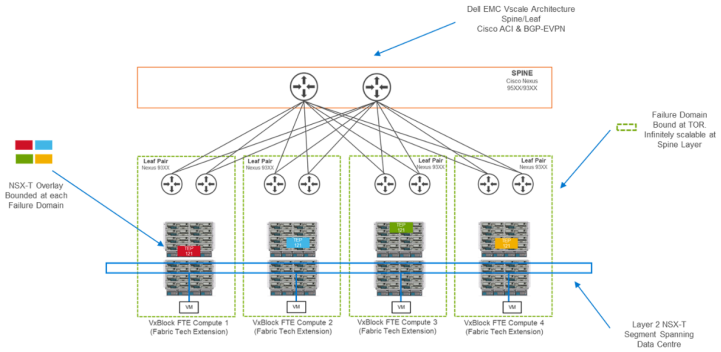Home > Integrated Products > VxBlock 1000 and 3-Tier Platform Reference Architectures > White Papers > Introducing VMware NSX-T into Dell EMC VxBlock 1000 > Physical underlay and network architecture
Physical underlay and network architecture
-
The physical network underlay serves as the transport medium for the software-defined network. Its design and architectural integrity are fundamental to the overall performance of the SDN stack. A problem at this layer can have a disruptive impact on performance. Thankfully, this is where the engineered excellence of the VxBlock 1000 comes into play. Each subcomponent of the physical network layer is highly redundant and is engineered for throughput, scale, and low latency. VxBlock components participating in the NSX-T underlay include the following:
- Cisco Nexus 9336-FX2 TOR Switches, supporting 1/10/25/40/100 GB connectivity and serve to physically connect to the external network.
- Cisco Gen 3 and Gen 4 series UCS Fabric Interconnects and IO Modules supporting a mix of 1/10/25/40 GB connectivity at the compute network layer:
- UCS 6332-16P, UCS 2348UPQ, UCS 6454-U, UCS 2232PP
- UCS 2204/2208 and UCS 2304
- Cisco UCS C220 M5 Servers serving at the NSX-T Edge layer with Cisco VIC 1457 and Intel XXV710-DA2. The latter is a critical consideration in the underlay design and provides hardware-based encapsulation/de-encapsulation and offloading from the GENEVE NSX-T based overlay and the external network. This card also supports the DPDK protocol.
- Cisco UCS B/C Series servers and supported VIC cards.
The Physical Underlay has been designed to scale. From the beginning, the modular architecture of the VxBlock platform means that the customer is not assuming the technical debt associated with a monolithic architecture. Given its ‘persistent architecture,’ as the platform evolves, new VxBlock 1000 components can be gracefully integrated into the underlay. These may include physical servers but also network interface cards and Virtual Interface Cards (VICs) that add new hardware offload and security features to the underlay.
Underlay at scale – Vscale and the spine/leaf architecture
The Underlay performs three primary functions. All other use cases depend on a well-designed and scalable underlay:
- A physical transport for the Overlay – The GENEVE encapsulated network. A mechanism in which tunnel endpoints can transport traffic to tunnel endpoints, that is, in which the system can transport SDN traffic from one SDN Node to another.
- A transport mechanism that takes encapsulated traffic to a location on the network where it can be de-encapsulated. This is known as the NSX-T Edge cluster. This ‘Edge’ is also the ‘ingress’ point for external traffic into the NSX-T SDN domain.
- Segregating the network into multiple distinct failure domains -- This was the original and still the fundamental use case of an SDN system. Traditional networks based on legacy distributed control plane protocols, such as Spanning-Tree and 3-Tier network architectures (Core/Aggregation/Access), scaled very poorly in the Data-Center and led to very large failure domains. An outage in a Data Center network, designed with large failure domains, was usually very impactful, not well contained, difficult to troubleshoot/resolve, and invariably negatively affected the financial and business bottom line. Furthermore, it was non-agile and difficult to change. Because of the potential risk, outages to facilitate additions, moves, and changes had to be very carefully planned and, in some instances, required executive oversight and approval.
Clearly this relationship between the technical system and business process did not meet the requirements of the digital revolution in an era in which applications and networks are required ‘on the fly’ for businesses to remain relevant, competitive, and successful.

Figure 8. Scalable architecture
The VxBlock 1000 with NSX-T is designed specifically with scalability in mind. The figure above shows how NSX-T, in combination with the Overlay, can scale in the Data Center by minimizing the failure domain footprint -- in this instance -- per Fabric-Interconnect pair. However, VxBlock 1000 in conjunction with Vscale can scale the NSX-T Data Plane almost infinitely at the ToR layer.
It can scale in this way by introducing a network architecture based upon ‘Spine/Leaf’ versus the traditional 3-Tier Core/Aggregation/Access Architecture. The Spanning Tree Protocol (STP) is eliminated as a Data Plane reachability protocol between failure domains and replaced by Layer 3 protocols such as BGP, BGP-EVPN, and IS-IS. These Layer 3 protocols are much more efficient for managing control and data plane reachability information and eliminate the use of STP between failure domains. For a deeper overview of the VxBlock architecture see Dell EMC VxBlock™ System 1000 Architecture Overview.
